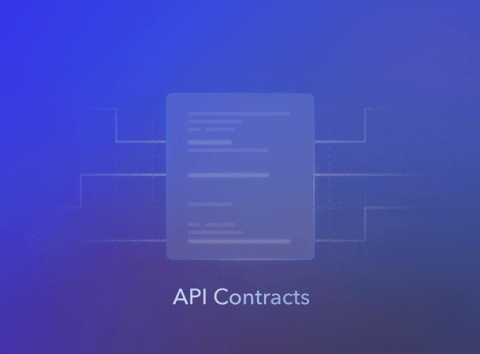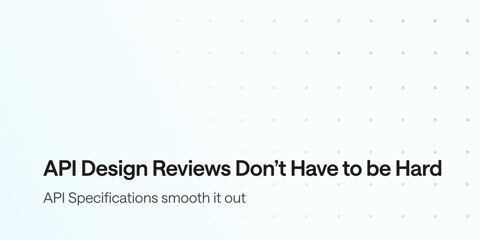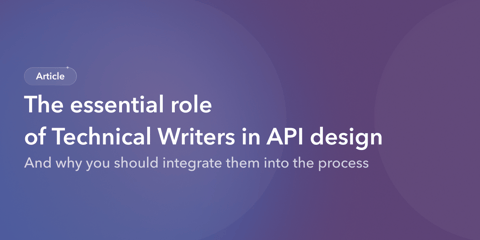API-first design is a software development approach built around the idea that the application programming interfaces (APIs) should be the primary focus of the development process, with other system components, such as the user interface (UI) being developed later.
API-first design is becoming increasingly important as more and more organizations are turning to microservices and other architectural patterns to improve their ability to scale, innovate, and adapt to changing business needs. This approach enables the development of flexible and modular systems that can be easily integrated with diverse systems and services.
In this article, you’ll learn about the principles of API-first design and how it can benefit your organization. You’ll understand how API-first design works and learn about the different stages of the API design process. By the end of this article, you’ll have a comprehensive understanding of the benefits of API-first design, and how Bump.sh can serve as the single source of truth for all your APIs.
Why Is API-first Design Important?
As mentioned, API-first design is a specific methodology for building software systems, where the API is designed and developed before any other system components. APIs are emphasized as a core part of the software development process rather than as an afterthought. In short, the API is considered the backbone of the software, and the rest of the system is built around it.
Code First v.s. API First - A change of software development philosophy.
— Alex Xu (@alexxubyte) November 16, 2022
The diagram below shows the differences between code-first development and API-first development. Why do we want to consider API first design?
1 of 10 pic.twitter.com/HKgSGYLOf9
API-first design is commonly applied in API-centric products. For example, companies like Stripe or Twilio offer their APIs as a core offering to customers, so they have to design them to be intuitive and user-friendly.
Companies using or moving to a microservice architecture will also often adopt an API-first design approach. Because APIs are so important in microservices, developing standards and a well-thought-out workflow through API-first design is very important.
When done well, API-first design offers a number of benefits:
Faster Development Times
By designing the API first, development teams can more easily work in parallel on different parts of an application. Having a well-documented API means that teams can stub out specific endpoints to test and build their own systems without having to have a running instance of every API on their machine.
Similarly, this improves coordination between frontend and backend teams. Frontend developers can build based on the assumption that the backend will adhere to the established documentation, allowing backend developers to work in parallel with them.
Finally, API-first design makes it easier to reuse endpoints and logic throughout the system. For example, if you’re building an e-commerce application, several parts of the application may need to estimate shipping costs (e.g., pricing page, checkout workflow, returns workflow, invoice generation, etc.). If there’s a single, documented endpoint available, you can ensure that each time it is called, the results will be the same.
Improved Developer Experience
It’s often easy to tell when a system wasn’t built with the API in mind because it uses clunky or non-standard endpoints. For example, I recently ran across an API that used the following endpoint to edit a user object:
POST http://api.example.com/v1/user/edit
While this approach technically works, it’s not common. Typically, in a REST API, modification of an object would use a PUT or PATCH request and include the object’s ID in the URL. So, consumers of this API must now very carefully read through all the documentation to be sure they use your API properly.
Whether API consumers are internal or external, systems designed with the API in mind first will almost always provide a better experience to developers. They’re more likely to use established standards which make them much easier and less frustrating to use.
Better Collaboration and Communication
Ultimately, all the advantages of API-first design come down to making communication and collaboration better.
When your API is clearly defined and agreed upon up-front, multiple teams can work in parallel, engineers can move from working with one API to another seamlessly, and errors in the implementation or consumption of APIs are more clear.
When is API-First the Wrong Approach?
Just because there are advantages to API-first design doesn’t mean it’s a panacea. For example, if you’re building a traditional server-rendered application without plans to offer an API, adding extra layers is a waste of time. API-first design can also hamper nascent projects that aren’t sure exactly how the data model will look when they’re finished.
Overengineering is a common problem in software development, and API-first design approaches are no different.
The API-First Design and Development Process
Now that you’ve seen some of the advantages an API-first process provides, let’s get into the practical aspects—what does API-first design look like?
As the name implies, API-first design dictates that you plan your API as part of the application development process, but like all software, your API needs to be open to change as the system around it changes.
Typically, a new API will undergo the following stages:
Define
This is the initial stage of the API lifecycle, where you’ll define and establish the API’s overall goals, requirements, and constraints. This stage is critical for setting the scope of the project and ensuring that the final API will meet the needs of its intended users and stakeholders.
At this point, you should consider the technical and service-level requirements, the data format users will prefer (JSON, XML, etc.), the data structure, and the downstream systems that rely on your API. You should also consider the audience for this API. Will it be publicly available? For private or internal use only? Or limited to verified partners?
Finally, you should define any key roles or processes your team will use while building and maintaining the API. You’ll need to decide on the tools you’re going to use to design and document the API as well as a plan for change management.
Design
Next, you will outline the API’s design and structure. Based on the performance, scalability, security, and other requirements outlined in the Define stage, you will need to make decisions like whether to use REST, GraphQL, or gRPC, how to authenticate and authorize consumers, and how to report and track errors.
During this stage, you can create API contracts that provide clear guidelines for the API’s behavior. Assuming an HTTP API, developers will often use a standard specification like OpenAPI or AsyncAPI to define the API’s operations (verb and URL) and response format. Having contracts like this allows developers to properly implement the API, and it lets consumers mock the API so they can build downstream applications.
Develop and Document
In the next stage, you will implement the API, and create the necessary documentation.
Traditionally, documentation has been a manual process, but API tooling has come a long way, and now you can use tools like Bump.sh to automatically generate your API documentation from your contract defined during the design phase. This allows your developers to focus on implementing the API and building internal business logic without having to worry if they’re keeping their documentation up to date.
As in building any web application, you’ll need to make decisions about the internal architecture of the API (framework, language, database, etc.), the ancillary services needed (message queues, notifications, etc.), and deployment options. If you’re in an established organization, many of these decisions might be mandated externally, but in greenfield projects, there’s often a lot of leeway.
Test
Before deploying an API, it’s important to thoroughly test it to ensure that it behaves as expected, meets the outlined spec, and will continue to behave as expected as the API changes. Typically, this includes unit testing, integration testing, and load testing. While automated testing should comprise the bulk of your API tests you’ll likely want to do some manual QA as well to catch any unexpected behaviors before you launch.
After launch, testing is equally important, so focus on building repeatable testing practices: run them as part of your CI pipeline, keep an eye on code coverage metrics, and don’t let test debt pile up. As you might imagine, these tests will be invaluable once your API starts changing and growing.
Secure
While security should have been considered at the design stage, this point is important enough to check again after implementation. You want to prevent any unauthorized use or abuse of your API to ensure that sensitive data is protected. Encryption, access controls, user authentication, and other security measures should all be tested and verified before deployment. All the security checks that can be repeated should also be included in your CI processes so they are conducted continuously.
Most high-stakes API projects will have penetration tests conducted by internal or external auditors. If you’re new to API security, familiarize yourself with the OWASP API Security Top 10 and make sure you’re covered.
Deploy
After testing and securing the API, you can deploy it for use by its intended audience. Obviously, the specifics of this step vary greatly depending on your tech and infrastructure stack, but most companies use multiple environments to ensure their API can be deployed and that changes don’t cause unintended consequences when they’re released.
Observe
Observability has come a long way in the past few years, and modern tools allow you to easily track your API’s usage, performance, access logs, and errors. Instrumentation should let you catch issues and help you understand how consumers are using the API.
Evolve
It is worth noting that this API development lifecycle isn’t a one-time process. Like most software projects, you’ll come back to implement changes frequently, so you’ll need to have a plan for implementing, testing, and announcing those changes.
Tools like Bump.sh can help with this as it can track structural changes to your API to automatically update a changelog and trigger a webhook to notify other services.
Finally, this lifecycle isn’t necessarily linear: you may need to move backward before you can move forwards. For example, during the development stage, teams may find that certain requirements must be re-evaluated or redesigned. Or, during the testing stage, they may discover issues that require changes to the API’s design or implementation. In such cases, teams may need to go back to a previous stage of the API lifecycle to address these issues before moving forward.
Developer API Tools
I’ve hinted at tooling a couple of times in this piece, but because it’s such an important part of building a great API, I’ll dig deeper here. There are a few categories of tools that are important when designing and building APIs, including:
- Documentation tools range from presentation-only tools to automatic doc generation tools. In any case, you’ll definitely need some way to document your API and manage changes.
- Mocking tools allow you to stub all or part of your API so consumers can work without a deployed version.
- Testing tools come in many different shapes and sizes but most will allow you to automatically run and call endpoints with various parameters to ensure the results match your expectations.
- An API browser can be helpful for browsing and troubleshooting endpoints or testing specific requests.
Finding the right mix of tools often comes down to personal preference, cost, and ease of use or implementation. Ultimately, what works for one company might not work for another, so it’s important to evaluate all the options in your unique context.
Conclusion
API-first design is a powerful way of building software that prioritizes APIs and their consumers. Development teams can create better products and more efficient workflows by designing APIs first and then building the rest of the application around them.
Additionally, by thinking about the API from the beginning of the development process, teams can better anticipate the needs of third-party developers and create a more user-friendly experience for them. Overall, API-first design is a key strategy for creating high-quality, effective APIs that are well-suited to the needs of modern software development.
Getting your API-first design efforts off the ground can be made easier with Bump.sh. Bump.sh is the simplest way to automatically create API documentation portals for internal, partners, and public APIs. Feel free to look at our solution, and please reach out to us if you have any feedback, comments, or suggestions you’d like to share. We’re always listening.


